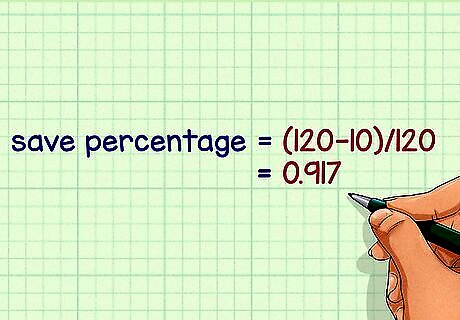
views
Calculate a Save Percentage in Baseball

Identify relief pitchers. Relief pitchers are the only players for whom the save percentage is calculated. The relief pitcher replaces the starting pitcher late in the game when his team holds a slight lead. The job of the relief pitcher is to keep his team from losing its lead and losing the game.

Search for save opportunities. A relief pitcher is not automatically eligible to earn a save simply by entering the game. The relief pitcher is only allowed to earn a save if the following conditions are met: Note the number of runs to be saved. The reliever must enter the game with no more than a 3-run lead and must pitch at least 1 inning. Such a situation would meet 1 of the criteria for a safe opportunity. Figure the position of the potential tying run. Note the opposing team's batting lineup. If all opposing runners on base were to score and 1 of those runs would tie the game, the game is eligible to be counted as a save opportunity. If all opposing batters on base scored and the opposing batter currently batting would represent the tying run, the game is eligible to be counted as a save opportunity. If all opposing players on base and the batter were to score, and the opposing batter on deck would be the tying run should that batter score, the game is eligible to be counted as a save opportunity. For example, if the relief pitcher entered the game with a 3-run lead, meeting the first criteria for a save opportunity, but there were no opposing batters on base, this game would not count as a save opportunity. In this example, even if the opposing batter and the on-deck batter were to score, the game would still not be tied. This example would not be counted as a safe opportunity. Check the number of innings pitched. If the reliever pitches 3 or more innings with a lead, it is at the discretion of the official scorer to designate this situation as a save opportunity.

Determine the number of saves. Saves are games that the team of the reliever won, and in which the reliever was credited with a save opportunity. The reliever must finish the game to be credited with a save.

Figure the save percentage. This is the number of saves divided by the number of credited save opportunities. Saves and save opportunities are tracked on a running basis during the season. Each game played by the reliever's team may cause a situation that will change the running season save percentage of the reliever.
Calculate a Save Percentage in Ice Hockey

Get the attacking numbers. Add up the total shots on goal made by each opposing team while the goalie was playing for all game situations to date in the season. Tabulate the total number of goals scored by the opposing teams in those situations.

Determine the save percentage. Save percentage is (the number of shots on goal minus the number of goals) divided by number of shots on goal. For example, a goaltender who faced 120 shots and allowed 10 goals would have a save percentage of (120-10)/120, or 0.917.
Calculate a Save Percentage in Lacrosse

Tabulate the opposing totals. Find the total number of shots on goal taken by all opposing teams. Get the total number of goals scored by all opposing teams.

Determine the save percentage. Save percentage is (the number of shots on goal minus the number of goals) divided by number of shots on goal. For example, a goalie who faced 73 shots and allowed 22 goals would have a save percentage of (73-22)/73, or 0.699.




















Comments
0 comment